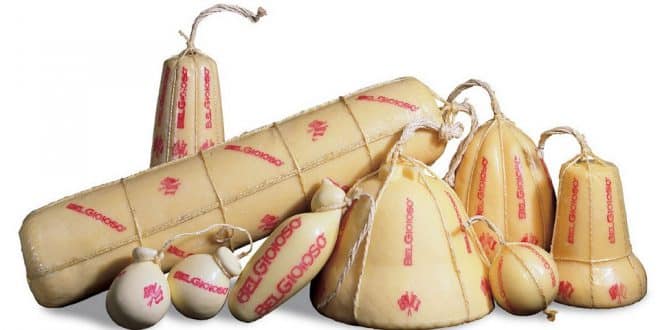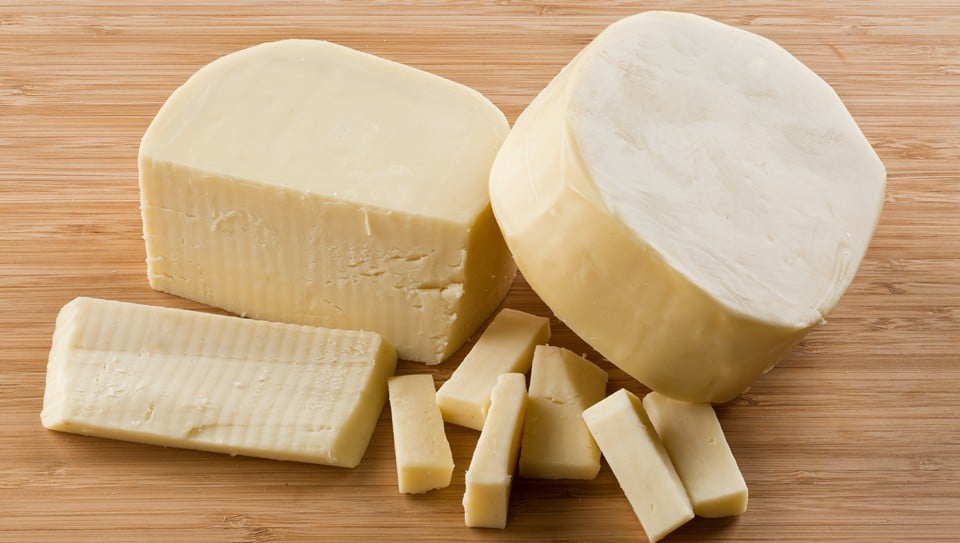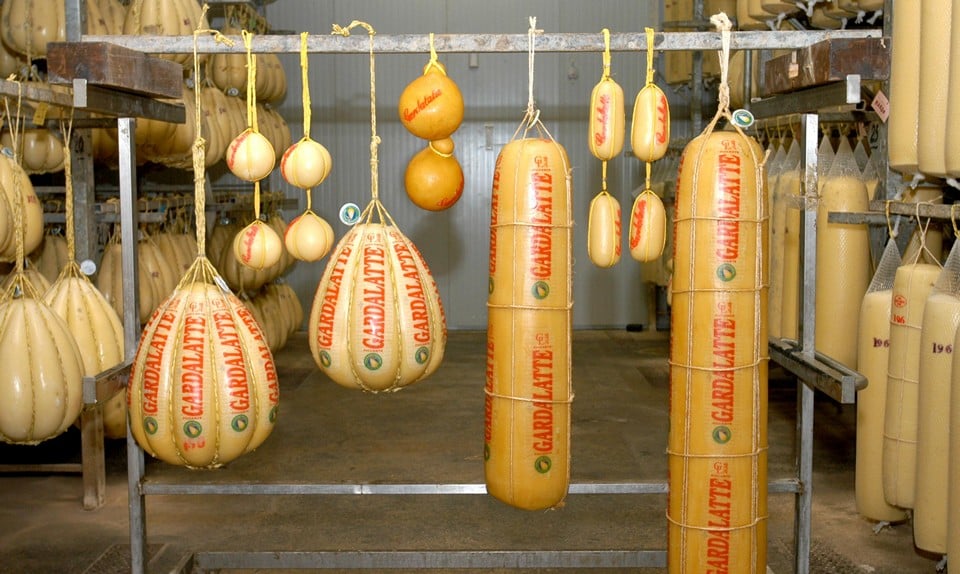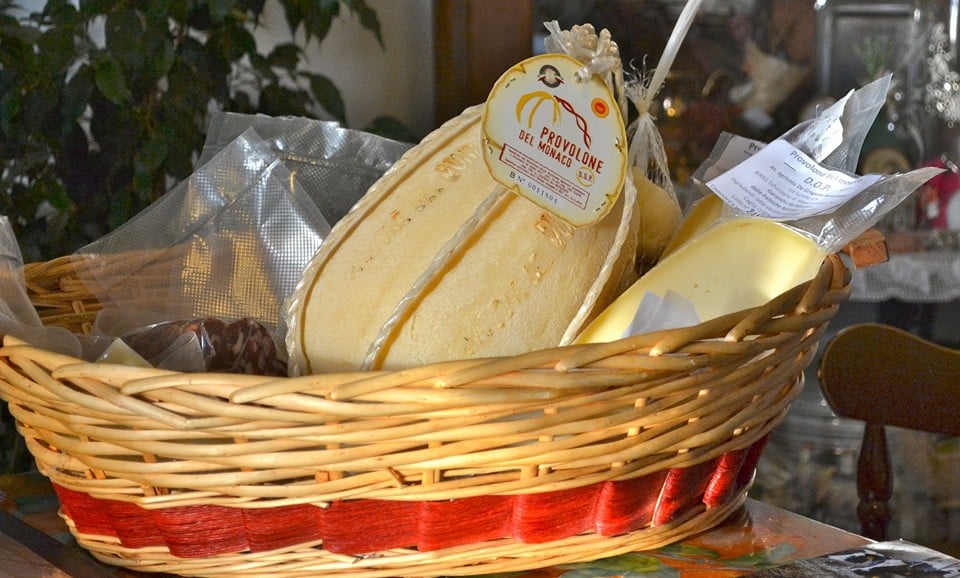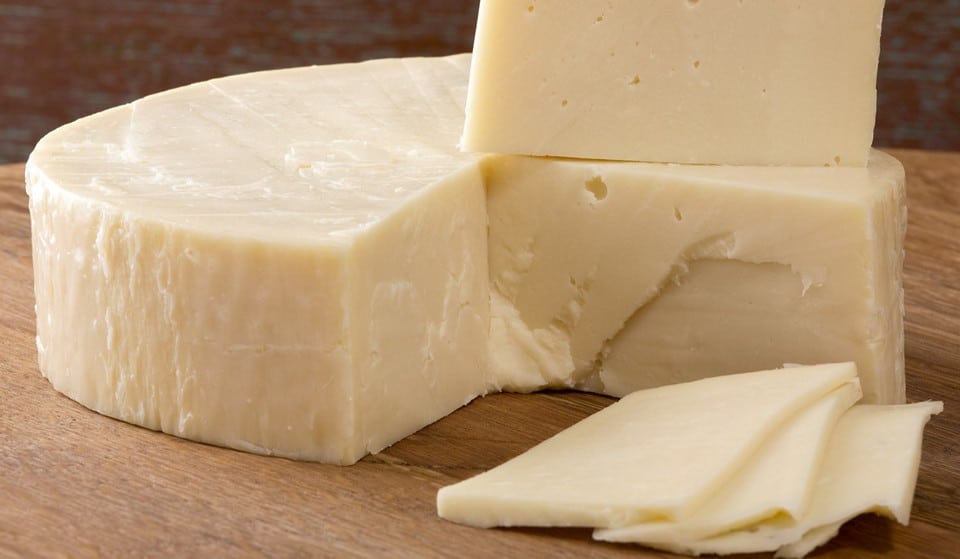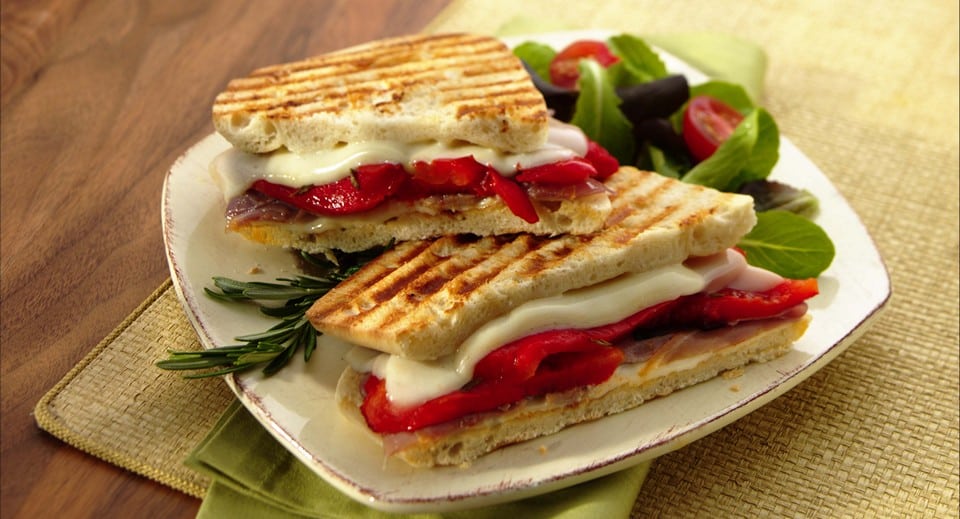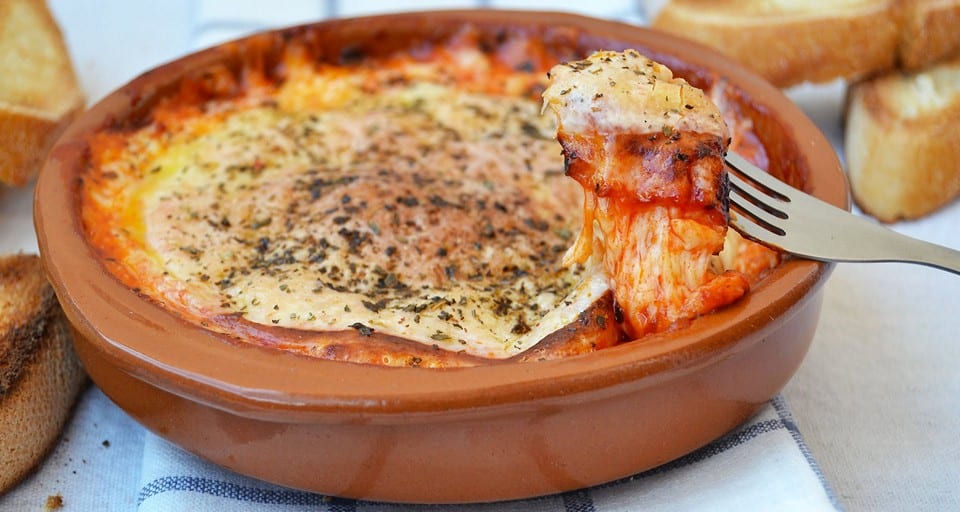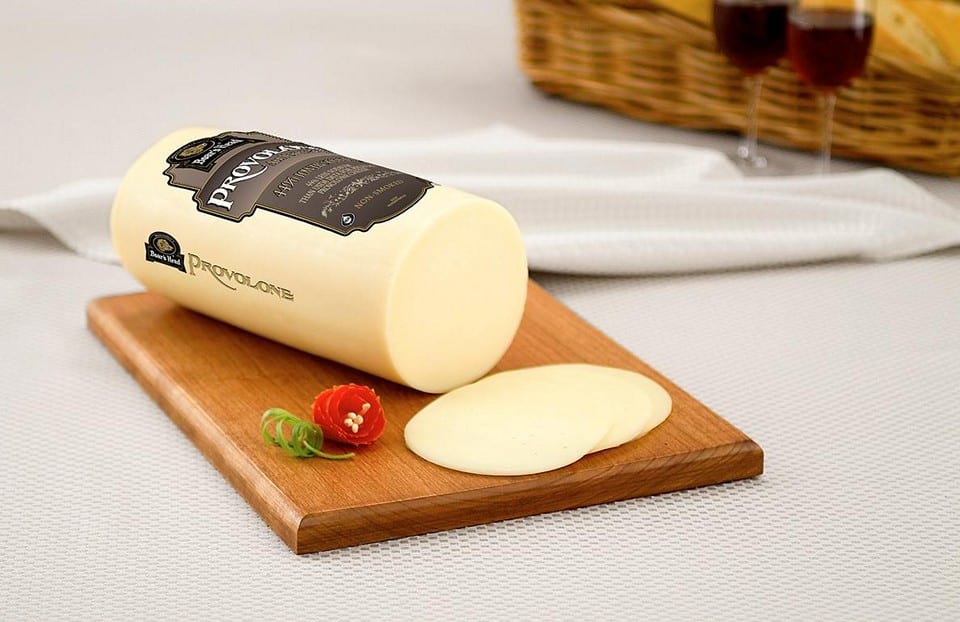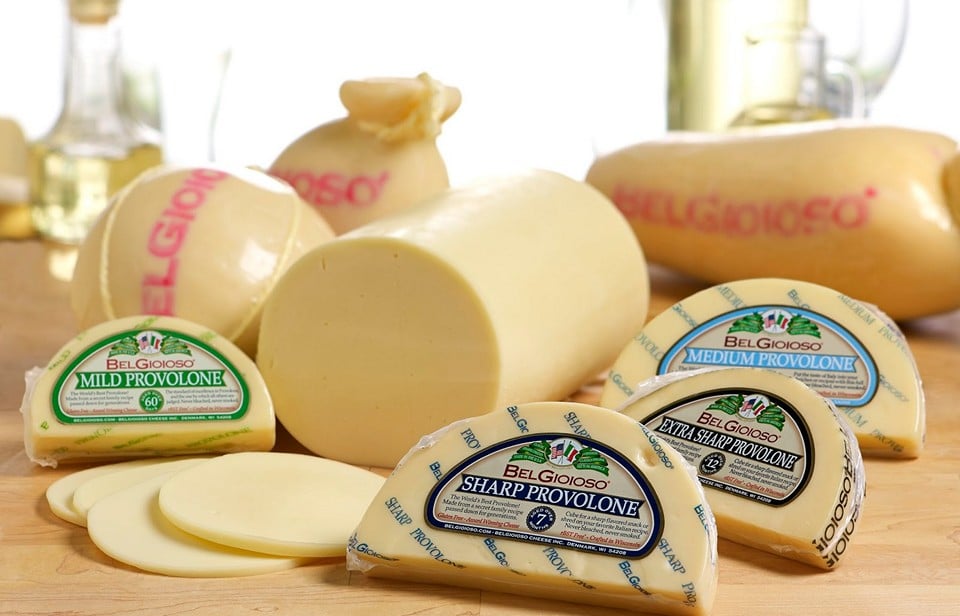Provolone is a firm Italian cheese with reduced fat content. It belongs to the category of “Paste Filate” (stretched curd) cheeses. Provolone has its uniqueness not only in taste and aroma but also in a wide variety of shapes.
You can find this cheese in the form of a pear, a tied sausage, a cone, a melon, or even a peeled mandarin. It’s truly a feast for the eyes! While the shapes may vary, the focus is not just on the cheese’s appearance but also on its consumption. So, let’s find out what this creature called Provolone is all about and what it pairs well with.
Page Contents
History of Occurrence
The history of Provolone has a relatively short timeline. It was born in the southern part of Italy in the second half of the 19th century. Its name originates from the Neapolitan word “provola,” which refers to its spherical shape.
The unification of Italy in 1861 allowed for the breaking of barriers between regions and provided an opportunity for cheesemakers from the southern regions to settle in the Po Valley. In order to increase the production of “paste filate” cheeses, which had fans both in the northern part of the country and abroad, the Italian government facilitated the transfer of dairy farms from the south to the north, where milk was abundantly available. This territory, rich in fertile lands, also had well-developed infrastructure, which contributed to scaling up the production and improving the quality of the cheese.
The name “Provolone” first appeared in literature in 1871 in Manchini’s “Dictionary of Agricultural Terms.” As a unique cheese, it differed from its counterparts in the category by its ability to mature for a long time without drying out. This characteristic later led to its widespread popularity.
In 1996, “Provolone Valpadana” and in 2010, “Provolone del Monaco” were granted the status of cheeses with protected designation of origin (DOP).
It is worth noting that Italians often refer to the classic “Provolone” without using prefixes but imply Valpadana when mentioning it.
How do they make it
In Italy, several versions of provolone are produced, two of which belong to the DOP category. Italian provola and provoleta are also varieties of the basic cheese. There is no need to study the specific production methods of each type, as the foundations of all recipes are very similar. Therefore, we will present to you the production technology of “Provolone Valpadana.”
Classic provolone is produced in several regions of Italy: Emilia-Romagna, Lombardy, and Veneto. The milk used is exclusively from the Frisian breed of cows. Today, as in the past, the curdling of the milk is achieved using animal rennet.
But before using the rennet, cheesemakers enrich the milk with whey starter (the liquid remaining in the vat after making cheese the previous day) and let it stand overnight. This substance is rich in microorganisms and valuable because the enzymes it contains are passed from cheese to cheese day after day.
At the second stage, the curd is cut and subjected to heating by immersing it in hot liquid to obtain a “stretchy” consistency characteristic of pasta filata cheeses.
Next, the cheese is placed in special perforated molds to give it its final shape: sphere, pear, cone, or mandarin. Before being sent for maturation, the final component is added – sea salt, by placing the cheese heads in a brine solution. Afterward, the provolone is washed in cold water and coated with wax to create a protective film.
“Binding” with special ropes is another tribute to the longstanding tradition. The maturation process can last several days or even over a year, depending on the type of cheese desired.
The weight of cheese heads can vary from a few hundred grams to 100 kg.
Provolone cheese (a variation distant from the classic) is also produced in the United States, Bolivia, Argentina, Brazil, and Uruguay. In these countries, the cheese is often made in the form of small cylinders, about 1-2 cm in height and 10-15 cm in diameter.
Characteristics of Provolone del Monaco
Provolone del Monaco is a DOP cheese produced in the province of Campania, from the milk of cows in the town of Agerola.
Peasants who brought their products to the port of Naples would wrap themselves in burlap cloaks to protect themselves from the cold and humidity. Neapolitan traders started referring to these farmers as “monks” due to their resemblance to monastic attire. Hence, the name of the cheese literally means “Provolone from the monks.”
Distinctive features of Del Monaco cheese:
- The cheese head, shaped like an elongated cantaloupe, weighs between 2.5 kg and 8 kg;
- The rind is thin, yellowish, almost smooth, with longitudinal grooves from the ropes that divide the cheese into 6 parts;
- The aging period is a minimum of 6 months;
- The cheese body is light yellow, firm, soft, and has characteristic “bird’s eye” holes;
- The fat content in the dry matter is no less than 40.5%;
- The taste is sweet, buttery, and slightly spicy.
The distinctive taste and aroma of the cheese are determined by the unique combination of characteristics of the milk used, the climatic conditions of the production area, and the traditional methods of preparation.
Varieties of Provolone
In Italy, only two varieties of classic Provolone are recognized: Dolce and Piccante. However, in other countries, smoked Provolone is included as a third option.
- Provolone Dolce, or sweet Provolone, is made from cow’s milk and coagulated with calf rennet. It matures for no more than 2-3 months. It has a creamy, milky, slightly sweet taste. The texture is smooth and soft. The cheese heads are relatively small, weighing up to 5.5 kg.
- Provolone Piccante, or sharp Provolone, is produced using rennet from lambs or kids. It ages for 3 months to a year or more. This cheese is drier, sharper, and spicier, with a firmer texture compared to Dolce. It has a strong aroma and a lingering aftertaste. The cheese heads can reach a weight of over 90 kg.
- Provolone Affumicato, or smoked Provolone, is made by smoking and further aging fresh cheese for a minimum of 3 months. Applewood is commonly used in smokehouses. It has a piquant taste with a subtle smoky aroma. The cheese mass is light yellow and firm. The rind color ranges from straw to light brown.
It’s worth noting that Piccante has the most pronounced flavor. If you have only tried the sweet variation, the aroma of mature cheese will be a pleasant discovery for you.
What to eat and how to store
When it comes to pairing and storage, the recipes using Provolone vary depending on the variety. The cheese is best enjoyed without heat treatment to fully appreciate its taste qualities.
Provolone cheese pairs perfectly with bread. However, if you prefer sesame or classic for a dolce (sweet) flavor, for piccante (spicy), it’s better to choose hard wheat varieties.
Sweet cheese is often enjoyed as part of a cheese platter with fresh vegetables, such as radishes, or olives. It pairs wonderfully with Cremona mustard, honey, and fig jam. Dolce cheese is used as an appetizer with sparkling classic wines or young fruit wines like Novello, Barbera, and Valcalepio.
Spicy provolone is versatile and enjoyed with fresh vegetables, olives, pears, and salami. It is often used grated as an ingredient in dishes such as omelets, pizza, pasta, pies, baked potatoes, bruschetta, and sandwiches. It pairs exceptionally well with aged red wines like Amarone della Valpolicella, Refosco, and Barbaresco.
Smoked cheese is consumed on its own or as a component of sandwiches.
Del Monaco cheese in Italy is served with hot bread or flatbreads and pairs well with mature red wines.
Substitutes
If you need to replace provolone in recipes, you can choose a suitable alternative such as mozzarella, Parmesan (ideally), or any domestic semi-hard cheese. However, it’s worth noting that it’s impossible to completely replicate the flavor profile of provolone without some loss in taste quality.
Storage
It is advisable to store the cheese in the least cold part of the refrigerator (not in the freezer or near the wall). When the cheese is sliced, it should be wrapped in plastic wrap, foil, paper, or cloth, and if possible, avoid contact with other varieties. Before serving, it’s recommended to take provolone out of the refrigerator at least an hour in advance.
Calories and Benefits of Provolone
The variety of provolone cheese does not significantly affect the nutrient content. Due to its relatively high calorie content, doctors recommend consuming no more than 30 grams per day. In this portion of cheese, the following nutrients are contained:
- 98 kcal, which represents about 5% of the daily norm (DN) based on a 2000-calorie diet;
- Fat: 7.5 grams (11% DN);
- Protein: 7.2 grams (14% DN);
- Carbohydrates: 0.6 grams (1% DN);
- Cholesterol: 19.3 milligrams (6% DN).
There is no need to be concerned about the presence of cholesterol because it is not the terrifying monster portrayed in advertisements that destroys the entire body. Instead, it is an essential component and plays a vital role in the synthesis of many hormones. However, it should be consumed moderately by healthy individuals.
Provolone is rich in vitamins and minerals:
- Calcium: 21% of the daily norm (DN) – promotes bone and tooth health, muscle function, and nerve impulse transmission.
- Phosphorus: 14% of the DN – maintains the integrity of bone and tooth tissue.
- Sodium: 10% of the DN – participates in the proper functioning of the nervous system and maintains fluid balance in the body. It is important to remember that excess sodium can lead to water retention and, consequently, increased blood pressure.
- Vitamin A: 5% of the DN – supports eye health, regulates bone growth and cell division.
- Vitamin B12: 7% of the DN – an important component for the proper functioning of the central nervous system (CNS) and involved in the synthesis of certain enzymes.
- Riboflavin: 5% of the DN – supports the immune system and regulates growth and reproductive functions in humans.
In many countries around the world, provolone is considered one of the healthiest cheeses.
Interesting facts about Provolone
- Provolone cheese has a rich history that dates back to the 19th century in southern Italy, where it was originally produced in the Campania region near Naples.
- The name “Provolone” comes from the Italian word “prova,” which means “proof.” This refers to the traditional method of testing the cheese’s readiness by stretching it, a process known as “prova del filo.”
- Provolone cheese is made from cow’s milk and is characterized by its smooth, pale-yellow interior and firm texture. The longer it ages, the more intense and sharp its flavor becomes.
- Did you know that Provolone cheese is available in two main varieties? Dolce (sweet) Provolone has a milder taste and is aged for a shorter time, while Piccante (sharp) Provolone is aged longer and boasts a stronger, tangy flavor.
- Provolone cheese is often used in Italian cuisine for both cooking and as a table cheese. It melts beautifully, making it perfect for dishes like lasagna, pizza, and panini, where it adds a creamy, savory touch.
- To add a unique twist to your next charcuterie board, try wrapping slices of Provolone cheese with cured meats like prosciutto or salami. The combination of flavors and textures will surely impress your guests.
- In Italian delis, you may come across aged Provolone cheeses hanging from the ceiling. This traditional method of aging allows the cheese to develop its distinct flavor and aroma.
FAQ about Provolone
Why Provolone is healthy?
Why is Provolone cheese so expensive?
Why is Provolone smoked?
What is special about Provolone cheese?
Why is Provolone a circle?
Can you eat Provolone raw?
Price in Italy
Due to the original recipe of production and the long maturation time, the price of DOP-grade provolone is quite high. In Italy, you can purchase it ranging from 5 to 12 euros per kilogram, depending on the manufacturer and the cheese’s maturity.
And there concludes our informative ten-minute session about provolone cheese, dear readers. Now you have one more argument in your arsenal, confirming that it’s impossible not to love Italy. Be bold, experiment, travel, and remember: “Man cannot live on bread alone but with a slice of provolone!”
 Italy for me From Italy with love
Italy for me From Italy with love

